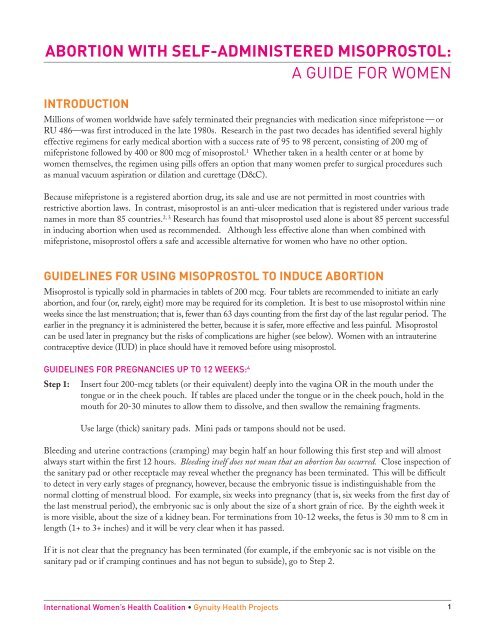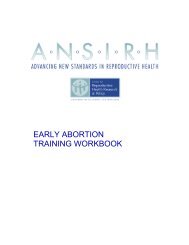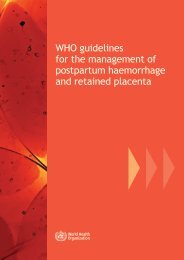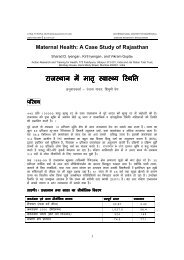abortion with self-administered misoprostol - Gynuity Health Projects
abortion with self-administered misoprostol - Gynuity Health Projects
abortion with self-administered misoprostol - Gynuity Health Projects
You also want an ePaper? Increase the reach of your titles
YUMPU automatically turns print PDFs into web optimized ePapers that Google loves.
ABORTION WITH SELF-ADMINISTERED MISOPROSTOL:A GUIDE FOR WOMENINTRODUCTIONMillions of women worldwide have safely terminated their pregnancies <strong>with</strong> medication since mifepristone — orRU 486—was first introduced in the late 1980s. Research in the past two decades has identified several highlyeffective regimens for early medical <strong>abortion</strong> <strong>with</strong> a success rate of 95 to 98 percent, consisting of 200 mg ofmifepristone followed by 400 or 800 mcg of <strong>misoprostol</strong>. 1 Whether taken in a health center or at home bywomen themselves, the regimen using pills offers an option that many women prefer to surgical procedures suchas manual vacuum aspiration or dilation and curettage (D&C).Because mifepristone is a registered <strong>abortion</strong> drug, its sale and use are not permitted in most countries <strong>with</strong>restrictive <strong>abortion</strong> laws. In contrast, <strong>misoprostol</strong> is an anti-ulcer medication that is registered under various tradenames in more than 85 countries. 2, 3 Research has found that <strong>misoprostol</strong> used alone is about 85 percent successfulin inducing <strong>abortion</strong> when used as recommended. Although less effective alone than when combined <strong>with</strong>mifepristone, <strong>misoprostol</strong> offers a safe and accessible alternative for women who have no other option.GUIDELINES FOR USING MISOPROSTOL TO INDUCE ABORTIONMisoprostol is typically sold in pharmacies in tablets of 200 mcg. Four tablets are recommended to initiate an early<strong>abortion</strong>, and four (or, rarely, eight) more may be required for its completion. It is best to use <strong>misoprostol</strong> <strong>with</strong>in nineweeks since the last menstruation; that is, fewer than 63 days counting from the first day of the last regular period. Theearlier in the pregnancy it is <strong>administered</strong> the better, because it is safer, more effective and less painful. Misoprostolcan be used later in pregnancy but the risks of complications are higher (see below). Women <strong>with</strong> an intrauterinecontraceptive device (IUD) in place should have it removed before using <strong>misoprostol</strong>.GUIDELINES FOR PREGNANCIES UP TO 12 WEEKS: 4Step 1: Insert four 200-mcg tablets (or their equivalent) deeply into the vagina OR in the mouth under thetongue or in the cheek pouch. If tables are placed under the tongue or in the cheek pouch, hold in themouth for 20-30 minutes to allow them to dissolve, and then swallow the remaining fragments.Use large (thick) sanitary pads. Mini pads or tampons should not be used.Bleeding and uterine contractions (cramping) may begin half an hour following this first step and will almostalways start <strong>with</strong>in the first 12 hours. Bleeding it<strong>self</strong> does not mean that an <strong>abortion</strong> has occurred. Close inspection ofthe sanitary pad or other receptacle may reveal whether the pregnancy has been terminated. This will be difficultto detect in very early stages of pregnancy, however, because the embryonic tissue is indistinguishable from thenormal clotting of menstrual blood. For example, six weeks into pregnancy (that is, six weeks from the first day ofthe last menstrual period), the embryonic sac is only about the size of a short grain of rice. By the eighth week itis more visible, about the size of a kidney bean. For terminations from 10-12 weeks, the fetus is 30 mm to 8 cm inlength (1+ to 3+ inches) and it will be very clear when it has passed.If it is not clear that the pregnancy has been terminated (for example, if the embryonic sac is not visible on thesanitary pad or if cramping continues and has not begun to subside), go to Step 2.International Women’s <strong>Health</strong> Coalition • <strong>Gynuity</strong> <strong>Health</strong> <strong>Projects</strong> 1
Step 2:If tablets were <strong>administered</strong> vaginally in Step 1, insert four more 200-mcg tablets of <strong>misoprostol</strong> deepinto the vagina three to 12 hours after the first administration.If tablets were <strong>administered</strong> by mouth in Step 1, place four more 200-mcg tablets under the tongue or inthe cheek pouch three hours after the first administration and hold them there for 20-30 minutes untilthey dissolve. The shorter time interval between steps for tablets in the mouth is needed to achieve thesame effectiveness as vaginal administration at longer intervals but may cause more side effects.Step 3:If the pregnancy has not been terminated after using the second set of pills and bleeding, insert fourmore 200 mcg tablets of <strong>misoprostol</strong> 3 to 12 hours after the second vaginal administration or threehours after the second administration by mouth.The majority of pregnancies up to 12 weeks duration are terminated <strong>with</strong>in hours of the first administrationof <strong>misoprostol</strong>. Generally, more than three-quarters of women experience an <strong>abortion</strong> <strong>with</strong>in the first 24hours, although it sometimes takes longer. 4 If unsuccessful, the entire process may be repeated.GUIDELINES FOR PREGNANCIES OF 13-20 WEEKS: 5Although <strong>misoprostol</strong> alone can also be used for second-trimester <strong>abortion</strong>s, the chances of serious complicationssuch as uterine rupture or hemorrhage rise as pregnancy advances. Ready access to emergency care in a medicalfacility is essential, and women should not attempt an <strong>abortion</strong> alone. They must also be prepared for the passingof a fetus and placenta at this stage.When bleeding and contractions begin, it is advisable to go to a hospital and report a miscarriage. The hospitalmay perform a surgical procedure—manual vacuum aspiration or D&C—to complete the process if it does notoccur naturally. Women should wipe the vagina clean of all pill fragments (which can last for days) before goingto the hospital. In countries where <strong>abortion</strong> is highly restricted by law, hospital personnel may be required toreport all induced <strong>abortion</strong> attempts to legal authorities.Step 1:Insert only two (not four) 200-mcg tablets in the vagina. The termination of second-trimester pregnanciesrequires lower doses of <strong>misoprostol</strong> because the uterus is more sensitive to the drug. Overdoses at thisstage of pregnancy are dangerous.Repeat Doses: Administer only two 200-mcg tablets every 3 hours up to a maximum of five applications. Theserepeat doses (if needed) may be inserted under the tongue or in the cheek cavity if heavy bleedingmakes it difficult to insert tablets vaginally.About half of women <strong>with</strong> pregnancies of 13-20 weeks experience an <strong>abortion</strong> <strong>with</strong>in 10-15 hours of the firstvaginal administration of <strong>misoprostol</strong>, <strong>with</strong> 80-90 percent of women completing the <strong>abortion</strong> <strong>with</strong>in 24 hours andmost of the remainder <strong>with</strong>in 72 hours. 5INTENDED EFFECTS AND SIDE EFFECTS OF MISOPROSTOLBleeding and uterine contractions (cramping) are the intended effects of using <strong>misoprostol</strong> for inducing an <strong>abortion</strong>. 1,4,5Cramping will be stronger than for an ordinary menstrual period and may be painful. Non-steroid anti-inflammatorypain medication such as ibuprofen may be taken <strong>with</strong>out interfering <strong>with</strong> the <strong>misoprostol</strong>. Bleeding will be heavier andmore prolonged than for a normal period: up to a week, in most cases, often <strong>with</strong> continued spotting until menstruationresumes in four to six weeks. These effects will be more pronounced in pregnancies of longer duration.International Women’s <strong>Health</strong> Coalition • <strong>Gynuity</strong> <strong>Health</strong> <strong>Projects</strong> 2
REFERENCES1. <strong>Gynuity</strong> <strong>Health</strong> <strong>Projects</strong>. 2009. Providing Medical Abortion in Low-Resource Settings: An Introductory Guidebook.Second Edition. New York: <strong>Gynuity</strong>.http://gynuity.org/downloads/MA_guidebook_2nd_ed_en.pdf.2. A. Faúndes et al. 2007. “Misoprostol for the termination of pregnancy up to 12 completed weeks of pregnancy.”International Journal of Gynecology & Obstetrics 99 (Supplement 2): S172-S177.http://www.<strong>misoprostol</strong>.org/File/IJGO_1triabn_Faundes.pdf.3. Maria M. Fernandez et al. 2009. “Assessing the global availability of <strong>misoprostol</strong>.” International Journal ofGynecology and Obstetrics 105:180-186.http://www.ipas.org/Library/Other/Assessing_the_global_availability_of_<strong>misoprostol</strong>.pdf.4. Luis Távera-Orozco et al. 2008. “Disponibilidad y uso obstétrico del <strong>misoprostol</strong> en los países de AméricaLatina y el Caribe.” Revista Peruana de Ginecología y Obstetrica 54:253-263.http://www.clacai.org/home/images/img/ArticuloMisoprostol.pdf.5. P. C. Ho et al. 2007. “Misoprostol for the termination of pregnancy <strong>with</strong> a live fetus at 13 to 26 weeks.”International Journal of Gynecology & Obstetrics 99 (Supplement 2):S178-S181.International Women’s <strong>Health</strong> Coalition • <strong>Gynuity</strong> <strong>Health</strong> <strong>Projects</strong> 4
















